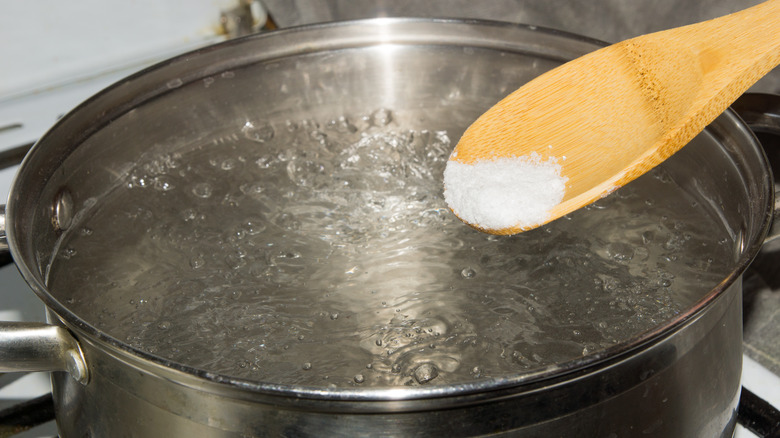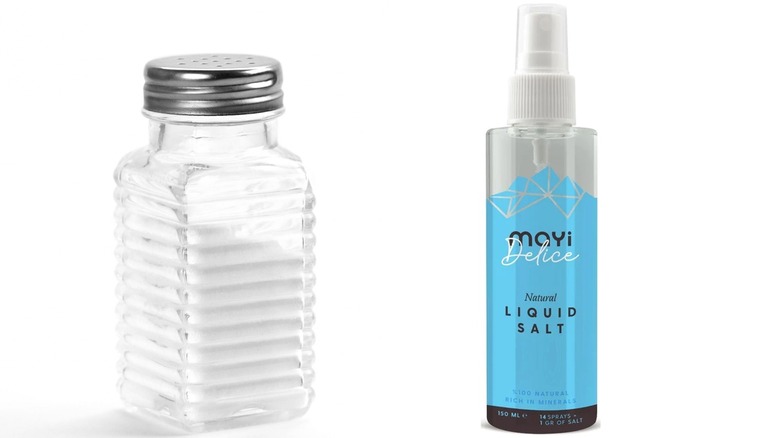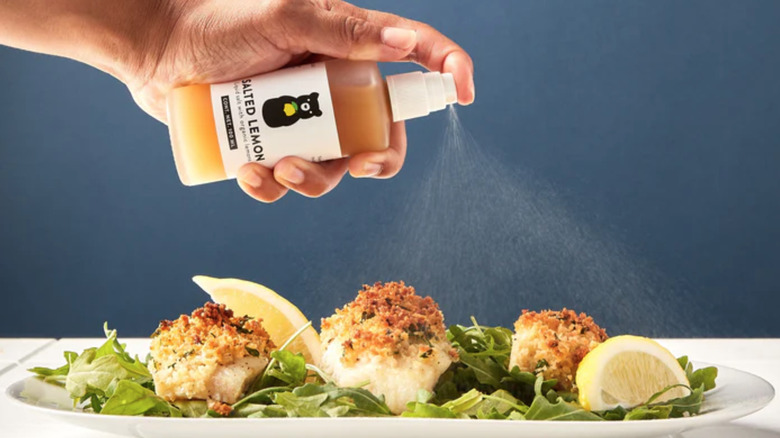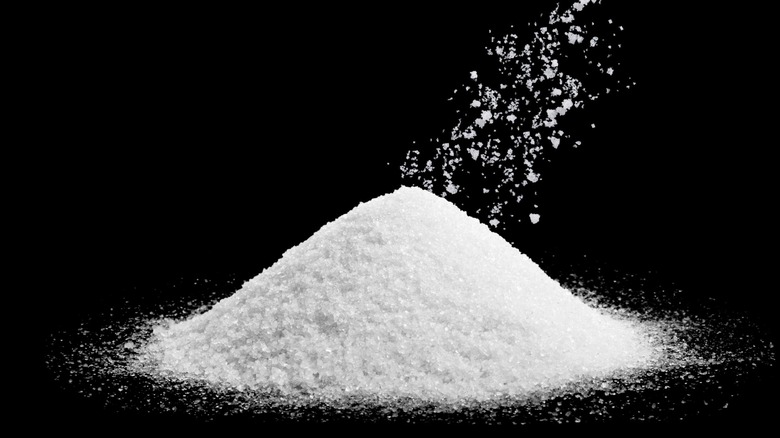Salt Spray Is The Secret Ingredient Everyone Should Have In Their Kitchen
It used to be that to experience a fine mist of salt spray you'd have to be walking along a seaside beach or hitting the ocean waves in your catamaran. Now salt spray can be found in a bottle in the kitchen, and it has become a favorite cooking tool.
Consider how grains of salt, when sprinkled from the fingers high over a sirloin steak or a plate of scrambled eggs, shower the food with salty goodness as the crystals scatter to all corners of the dish or pan. Those sharp, angular crystals do bounce though, and sometimes fail to settle on all the parts of the dish you'd like them to. That is just one problem that the ingenuity of a salt spray solves.
We're not talking about a high-powered blast of dry salt crystals here — rather, these are liquid salt sprays. They consist of salt dissolved in water to make a concentrated brine, and flavorings or herbs may be added in as well. The liquid is then packaged in spritzer bottles, so cooks can add an even mist of salt over any dish or drink they desire.
How salt sprays are made
At its most basic, salt spray is made by dissolving salt in hot water; one tablespoon of fine-grained salt to one cup of water is the recommended ratio. To achieve the purest-tasting salt spray, brands craft them using filtered water and with salts that contain no iodine or other additives. If you choose to make your own liquid salt, remember that dry salt is measured by volume: when working with coarse, larger-crystal types like kosher salt or sea salt, to get the same level of salty flavor you'll need to use more than when using fine-grained salts.
The amount of sodium in salt spray will vary depending on the brand. Even though these liquids tend to be very salty-tasting, some brands claim that using sprays instead of dry salt is actually a great way to cut back on sodium. That's because it disperses over food more evenly, so just a pump or two of the liquid mixture adds plenty of flavor to foods.
Dry salt vs. salt spray
Salt as it's typically used in cooking consists of dry crystals that are harvested from salt mines or seawater. There are many textures available, from salt flakes to the large crystals of sea salts and kosher salts, all the way down to fine, sand-like table salt. Because of these different crystal sizes, home cooks have to be mindful of the fact that a dish seasoned with a teaspoon of fine salt will be much saltier than one seasoned with a teaspoon of coarse salt. Salts may also contain additives such as iodine or anticaking agents.
Dry salt can be used to season foods as they cook — by adding it to cooking water, sauces, or over ingredients in the pan — and it can also be used to season food just before eating, for a finishing touch of saltiness and crunchy texture.
Salt spray is salt dissolved in water, alone or with other flavorings. Its purpose is for spritzing over foods or drinks, not to be measured out the way dry salt is. Because of this, salt spray is more practical as a finishing ingredient for dishes rather than as a component during cooking. The spray bottle disperses the concentrated saline as a fine mist that clings to the surface of both wet and dry foods, providing an even flavor boost. It's ideal to use with cocktails for a spritz of salty flavor with no worries about undissolved crystals.
How to cook with salt spray
Salt spray is very concentrated — case in point, the brand Nova Scotia says their sea salt food spray is "concentrated to eight times ocean water." Now that's salty! That's why whether you purchase it or make your own, just one or two spritzes make a huge difference in flavor. This goes for seasoning finished dishes to enhancing the flavors of individual ingredients. Remember that salt spray is meant to be a finishing touch, resting on the surface of your food. Don't eliminate other seasonings or all of the salt called for in a recipe, although you can experiment with reducing the amount of salt somewhat since more will be added at the end.
Add a mist of salt spray to foods after plating instead of using a salt shaker. You can also let guests spray on their own salt, especially helpful for those watching their sodium intake. Use salt spray to flavor almost anything: salads, corn on the cob, ceviche and other fish dishes, pasta dishes, and grilled meats.
Give a little spritz to cocktails to enhance the natural flavors of spirits like bourbon, rum, and tequila. Try salt sprays with desserts too, especially when they include ingredients like chocolate or caramel that taste incredible with a little salt. One type of food to be cautious with is those with crispy surfaces like fried chicken or crusty breads. Use a light hand when adding salt spray as too much will make crispy surfaces soggy.
Where to find salt spray
Making your own salt spray at home is pretty easy: just dissolve enough salt in hot water to make a very salty liquid, let it cool, then pour it into a food-safe spray bottle. However, it's worth keeping an eye out for salt sprays to purchase too, since many incorporate unique flavorings; for example, the store at Milk Street Kitchen has salt spray flavors that include lemon and wasabi. Check for salt sprays at specialty food stores, especially high-end shops that may carry those from small businesses specializing in harvesting sea salts.
You can also check for salt sprays in online shops, however, be sure the spray you're buying is meant for cooking. There are many products out there labeled as salt sprays that are actually for hair styling or home freshening, and these could contain fragrances or other ingredients not meant for eating. Food-safe salt spray should contain water and salt; flavored varieties may also have natural aromatics like citrus zest and herbs.
Store bottled salt spray at room temperature. Over time, a crust of salt may form on the nozzle and clog it, but this can be removed by washing the nozzle under warm water.
Salt sprays are a seriously underrated creation. Add them to your arsenal of kitchen tools and essential ingredients; there'll be no end to the dishes and drinks that you find become much tastier with a simple, salty spritz.




